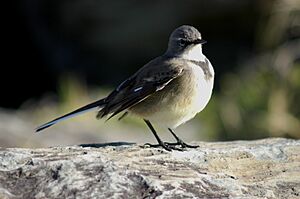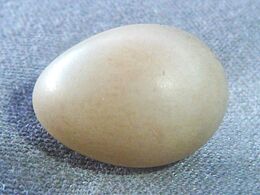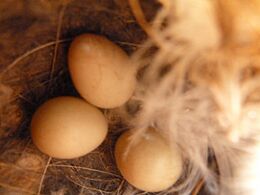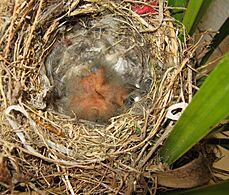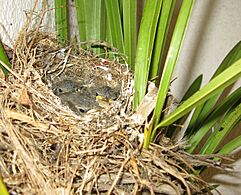Cape wagtail facts for kids
Quick facts for kids Cape wagtail |
|
|---|---|
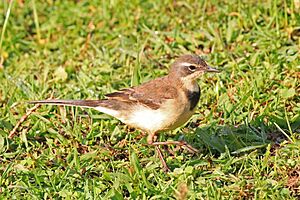 |
|
| M. c. wellsi at Lake Bunyonyi, Uganda | |
| Conservation status | |
| Scientific classification | |
 |
|
| Range, showing subspecies:
M. capensis wellsi M. capensis simplicissima M. capensis capensis |
The Cape wagtail (Motacilla capensis) is a small, active bird found all over southern Africa. It's also sometimes called Wells's wagtail. These birds love to hang out near water, on lawns, and in gardens. They mostly stay in one place, defending their territory, but some might move to higher or lower places depending on the season. Like other wagtails, they are passerine birds, which means they are perching birds. They belong to the Motacillidae family, which also includes pipits and longclaws.
Contents
About the Cape Wagtail
The Cape wagtail has feathers that are not very bright. Its chest and face are olive-grey, with a light tan stripe above its eye. Its belly is creamy white, sometimes with a faint pinkish tint. The wings are brownish-black with light edges, and the tail is dark. The two outer tail feathers are white. Young wagtails look similar to adults but are browner on top and yellower underneath. Male and female wagtails look the same. They also have a cool black triangle shape on their chest.
Where Do Cape Wagtails Live?
Cape wagtails live in eastern and southern Africa. You can find them from Uganda and Kenya all the way down to the Western Cape in South Africa.
These birds can live in almost any place that has open ground near water. This includes rocky coastlines, farms, villages, parks, gardens, and even cities. In eastern Africa, they are usually found in higher places, above 2,000 meters (about 6,500 feet).
What Do Cape Wagtails Eat?
Cape wagtails mainly eat small creatures without backbones, like insects. They usually look for food on the ground or in shallow water. They have even been seen eating insects attracted to lights or stuck on car radiators! Sometimes, they also eat small crabs, snails, ticks, tadpoles, tiny fish, small chameleons, and even human food.
How Do Cape Wagtails Behave?
Cape wagtails are usually found in pairs. They are territorial, meaning they defend their living space. A male and female pair will often stay together for many breeding seasons. Like many birds that defend their territory, male wagtails might even attack their own reflection if they see it in a mirror or window!
Nesting and Raising Young
Both the male and female wagtail help build the nest. It's shaped like a cup and made from many different things, both natural and artificial. They line it with soft materials like hair, roots, wool, and feathers. They often build their nests in hidden spots, like a hole in a steep bank, a tree, a bush, or even in man-made places like a hole in a wall, a plant pot, or under a bridge.
Cape wagtails can breed all year round, but they lay most of their eggs from July to December. They usually lay between one and five eggs. Both parents take turns sitting on the eggs for about 13 to 15 days until they hatch. Once the chicks are born, both parents feed them. The young birds leave the nest after about 14 to 18 days. Even after they leave the nest, the parents keep feeding them for another 20 to 25 days. The young wagtails become fully independent when they are about 44 to 60 days old.
Threats to Cape Wagtails
Sometimes, other birds called "brood parasites" lay their eggs in a Cape wagtail's nest. These include the Diderick cuckoo, Jacobin cuckoo, and Levaillant's cuckoo. This means the wagtails end up raising the cuckoo chicks instead of their own. Predators that hunt Cape wagtails include the rufous-breasted sparrowhawk, as well as cats and rats.
Images for kids



